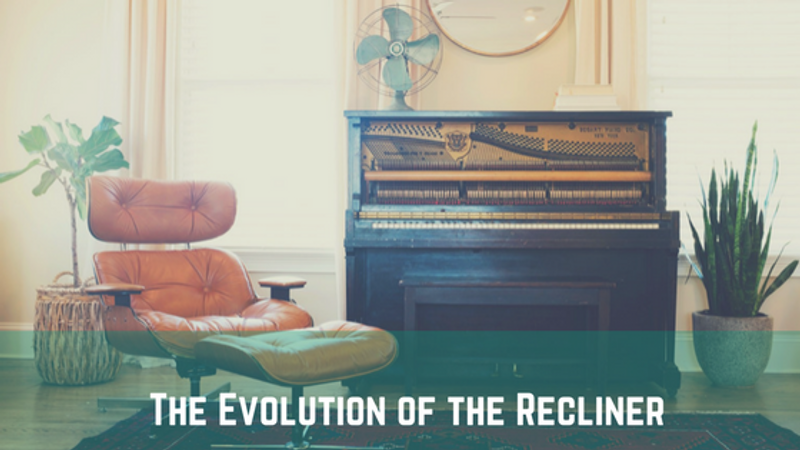
The reclining chair is a modern symbol of bachelorhood, of man-caves, Saturday night hockey with your granddad and of a universal feeling of “ahhhhh.” These lumbar-soothing pieces of furniture have gone through many reinventions over the years, and have all sought to provide comfort and relaxation to supine positions everywhere.
What were once chairs reserved for notable leaders, royalty, and military personnel are now staples of many rec rooms, basements, living rooms, and even in airplanes and trains. Recliners may seem to be a straightforward invention, but their history and evolution may just surprise you.
The History of the Recliner
Etymology
Directly from the Latin reclinare, meaning “to be bent back, to lean back; cause to lean,” the word recline was modernized by the French in the early 15th century, meaning to rest, lay; bend over.” The term recliner was made popular in 1660’s France, as an agent noun from recline.
Recliner 101
One of the earliest designs using the term “reclining” was published in a British periodical in 1813 called Ackennan’s Repository of Arts. It was a prototype for others to follow. The British called it a Morris Chair, and its invention spurred the music hit “You’d Be Surprised” by Jazz artist Irving Berlin. In 1855, iconic Philadelphia cabinetmaker George Henkels built a reclining chair which could be manipulated without complicated machinery and mechanisms.
Thought to be an American invention, the recliner as we know it today was actually born around 1850, when the French military introduced a reclining bed for camp use that could serve as a chair, chaise lounge, and a bed. It was designed to be portable and featured a steel frame and padded armrests. One of such recliners was supposedly owned by Napoleon III - the nephew of French emperor Napoleon Bonaparte - and while it was much less complex than its modern day counterparts, functioned very similarly to today’s recliners.
Fast forward to the late 1920’s and two American cousins, Knabush and Shoemaker, were issued a patent for the wooden bench recliner. It was this patent that would lead the way to the well-known La-Z-Boy recliner. In 1930, the cousins patented an upholstered model with mechanical movement, allowing people to lean back with the assist of integrated levers on the side of the chair.
In 1947 the cousins patented a reclining chair model complete with an integrated footrest, a feature which would become standard in recliner design. While Knabush and Shoemaker were not the first to develop a reclining chair, they were some of the first to market it as such, building recognition for their product.
In 1959, a patent for a recliner filed by Daniel F. Caldemeyer of the National Furniture Mfg. Co based in Indiana initiated widespread home use of the recliner with a product he dubbed a “rocket recliner.” The rocket name was based on Caldemayer’s knowledge of kinetics developed while he served with the US Air Force. Caldemayer’s design was integrated into the Mercury, Gemini and Apollo missions by NASA. He was granted over 300 patents for reclining chair technology, and was also responsible for the inclusion of heat massage and held a patent for the first entertainment centre.
In 1968, a massage therapist named David Palmer created a massaging chair that aimed to shake and jiggle all of the sitter’s knots out of their weary backs. Called the Chair in a Box, it wasn’t exactly a recliner, but paved the way for the formal invention of robotic recliner chairs brought to the public by Japanese Family Fujiryoki, founded in 1954. This style of robotic massage recliner grew popular in North America, but remains a staple of Japanese relaxation culture where it's estimated that about 20% of households own a massaging recliner.
In 1969, Knabush and Shoemaker began designing and introducing other products to the market based on the popularity of their upholstered recliners, like reclining couches and sleep sofas. In 1983, the company began to introduce stationary furniture. The quintessential namesake company that was founded on recliner chairs now brings in an annual revenue of $1.4 billion and employs over 11,000 people.
Recliners in the Media
The media and television worlds help to make the recliner a staple of middle-class, working Americans when they broadcast All in the Family in 1971, in which Archie Bunker preaches from his pale yellow recliner. In the 1990’s, the monumentally popular sitcom Friends premiered Joey and Chandler’s love for their matching recliners.
Postmodern Influence
Recliners have long been oversized, plush and foreboding accessories of living room feng-shui. They’re comfort and size is largely attributed to a glorification of excess - and we mean that as a compliment. These days, recliners can cost upwards of $10,000 and are controlled by computers and feature WiFi connectivity, have medical-grade massaging and heating elements, ergonomic-inspired lumbar support, feature cup holders and pull-out food trays - and some can even accommodate and chill a frosty 6-pack in the armrest.
Over the years, the adaptation of aesthetics in furniture design has slimmed down, become leaner, and experimented with minimalist design principles and more exotic materials.
In the postmodern era, we’ve seen recliners evolve from large, cushy solo-sofa’s into sleek and attractive recliners that explore spatial sensibilities and seemingly European artistry. They use wood, leather, metals, and industrial inspirations to deploy a new identity for recliners. Some even utilize matching ottomans in replacement of the kick-out footrest. They take up less space, and deter the man-cave sensibility of their forebearers, but the level of comfort offered is still the main ingredient.
The big brutish-hen versions still exist, and still provide ample comfort - but it’s this natural progression that’s changing the recliner from “Dad’s chair” into an all-family crowd-pleaser that’s becoming a staple feature of many tasteful interior designs.

